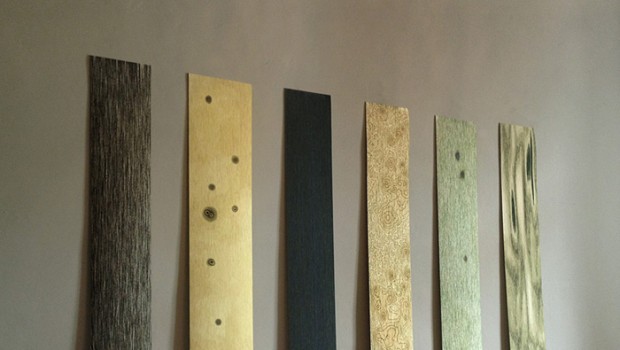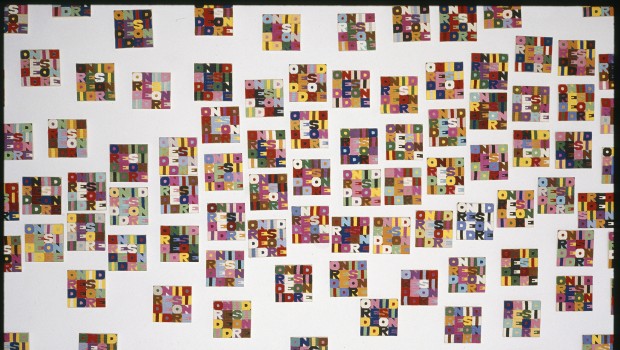The War of the Termite
La guerra de las termitas
Lorena Marrón
For the multidisciplinary Mexican artist Emilio Chapela, the communication networks, as well as the search engines, cybernetic tools, and digital programs, are ideal spaces in which to encounter society’s miscalculations, irregularities, and absurdities.
In this, his first solo exhibition at Gallery 11 x 7, Chapela shows us –through digital drawings, an installation and a video– the imprecisions that lurk hidden behind every digital transaction, the defects that every plan supposes.
In The War of the Termites the viewer will find, from the outset, a series of hybrid objects: digital drawings meticulously executed by the artist to simulate the effect of a real material (a wooden panel), each one these drawings printed on a sheet of 315 grams made completely out of wood. Meaning that the effect of the wood is printed on a derivative of the wood itself, and both because of this and because of the veracity of the drawing strokes, the artificiality of these objects is not obvious from a distance. Indeed, at first sight it would seem that Chapela had performed an act of appropriation or produced a sort of ready-made. It is only when we come closer –and see these objects in detail– that we become aware of their artificiality. The “woods” do not give off their particular aroma nor does the porousness of their texture appear anywhere. The optical illusion that these surfaces provoke can take us back to the Op art of the seventies, but Chapela goes far beyond the seduction of tromp d’oeil: whereas on the surfaces of these pieces the trickery is visible, in the medium of each of them the organic element to which the representation refers subsists. This play of contrasts –between the organic and the artificial– is a good starting point for beginning to dialogue with The War of the Termites, since such play permeates the entire exhibition.
In 2007 Chapela made Crumpled Paper, a series of drawings –by hand– in which he followed and marked all the lines produced on a sheet of paper after it had been crumpled by hand and squeezed into a little ball. Here the artist presents a variation on this work: a series of new drawings that imitate these exercises, only now from the computer. That is to say: what we see here are drawings in which it seems that the paper was crumpled and then smoothed out, but in reality the “crumplings” that appear on these sheets are digital strokes and not three-dimensional folds. These drawings are also hybrid objects: the simulacrum of a sheet of paper is printed over a sheet of paper. This series might remind us of Sol LeWitt and his minimalist drawings. But Chapela, unlike LeWitt –who drew following a set of inviolable rules–, dares to improvise a little and, instead of following an order, seeks to imitate chance.
In these series Chapela does not aim to produce a new version of the “real” but rather to place at risk the idea of reality we’ve constructed for ourselves. That intention also pervades the work Hexágono #8482, Anaquel #5 [Hexagon #8482, Shelf #5]: a collection of 32 wooden “books” arranged along a shelf, which also, to the viewer’s astonishment, form part of this constellation of simulacra. Chapela’s books are bereft of all utilitarian value: they are neither consumer goods nor items for leisure, nor is there any chance of their becoming either. They may be mock-ups of books that will never reach their final destination, their telos: to be read. If the project of modernity has told us over and over again that there exists an aim and an end-point and that everything advances toward somewhere, Chapela scorns such discourse and accordingly destabilizes any notion of “reality.”
The last piece is a video in loop that bears the show’s title. Here Chapela imitates the “noise” or “static” effect that appears on the television when there is no signal through a high-speed sequence of images of hundreds of woods. In other languages (Romanian, Swedish, Hungarian, and Danish, for instance) this static is known as the “war of the ants.” In this instance, Chapela has metaphorically placed in combat mode not ants but termites (which, we must remember, feed on cellulose, a component both of paper and wood, the two materials presented in this exhibition).
All the pieces that make up The War of the Termites –the simulated static, the scentless, textureless woods, the crumpled yet fold-less papers– force us to rethink the concept of reality and to conceive the world as Jean Baudrillard imagined it starting in the 1970s: a world that challenges the discourse of the real and “aspires to the status of illusion, restoring the non-veracity of facts, the non-signification of the world, advancing the opposite hypothesis that there is nothing rather than something.”
Para el artista multidisciplinario mexicano Emilio Chapela, las redes de comunicación, así como los buscadores, las herramientas cibernéticas y los programas digitales, son espacios óptimos para conocer los desaciertos, irregularidades y absurdos de la sociedad.[1] En ésta, su primera exposición individual en la galería 11 x 7, Chapela nos muestra –a través de dibujos digitales, una instalación y un video– las imprecisiones que se esconden detrás de toda transacción digital, las fallas que supone todo proyecto.
En La guerra de las termitas el espectador encontrará, de entrada, una serie de objetos híbridos: dibujos digitales elaborados meticulosamente por el artista para simular el efecto de un material real (una tabla de madera) impresos cada uno sobre una hoja de 315 gramos fabricada completamente de madera. Es decir: el efecto de la madera está impreso sobre un derivado de la madera misma, y tanto por eso como por la veracidad de los trazos la artificialidad de esos objetos no es evidente a la distancia. Incluso, a primera vista parecería que Chapela hubiera realizado un acto de apropiación o una suerte de ready-made. Es solo cuando nos acercamos –y vemos con detalle esos objetos– que nos percatamos de su artificio. Las “maderas” no despiden su particular aroma ni aparece por ninguna parte la porosidad de su textura. La ilusión óptica que provocan estas superficies podría remitirnos al Op art de los años sesenta, pero Chapela va mucho más allá de la seducción del tromp d’oeil: mientras que en la superficie de las piezas es visible el truco, en el soporte de cada una de ellas reside el elemento orgánico al que se refiere la representación. Este juego de contrastes –entre lo orgánico y lo artificial– es un buen punto de partida para comenzar a dialogar con La guerra de las termitas, ya que se encuentra presente a lo largo de toda la exposición.
En 2007 Chapela realizó Crumbled Paper, una serie de dibujos –a mano– en los que seguía y marcaba todas las líneas que quedaban inscritas en una hoja de papel después de que ésta había sido arrugada con las manos hasta “hacerla bolita”. Aquí el artista presenta una variación de aquella obra: una serie de nuevos dibujos que imitan ese ejercicio pero esta vez desde la computadora. Dicho de otro modo: lo que aquí vemos son dibujos en los que parece que el papel fue arrugado y después aplanado, pero en realidad las “arrugas” que aparecen en esas hojas son trazos digitales y no pliegues tridimensionales. Estos dibujos son también objetos híbridos: el simulacro de una hoja de papel está impreso sobre una hoja de papel. Esta serie podría hacer pensar en Sol LeWitt y en sus dibujos minimalistas. Pero Chapela, al revés de LeWitt –quien dibujaba siguiendo un set de reglas inviolables–, se atreve a improvisar un poco y, en vez de seguir un orden, busca imitar el azar.
En estas series Chapela no pretende producir una nueva versión de lo “real” sino poner en riesgo la idea de realidad que hemos construido para nosotros mismos. Esa intención atraviesa también la obra Hexágono #8482, Anaquel #5: una colección de 32 “libros” de madera que, dispuestos sobre una repisa, también forman parte, para sorpresa del espectador, de esta constelación de simulacros. Los libros de Chapela están despojados de todo valor utilitario: no son bienes de consumo ni de ocio, ni tienen posibilidad de serlo. Son, acaso, maquetas de libros que nunca van a alcanzar su destino final (telos): ser leídos. Si el proyecto moderno nos dijo una y otra vez que existe un propósito y un fin y que todo avanza hacia alguna parte, Chapela desdeña ese discurso y desestabiliza, de paso, toda noción de “realidad”.
La última pieza es un video en loop que lleva el título de la exposición. Aquí Chapela imita el efecto de “ruido” o “estática” que aparece en el televisor cuando no hay señal a través de una secuencia en alta velocidad de imágenes de cientos de maderas. En otros idiomas (el rumano, el sueco, el húngaro y el danés, por ejemplo) a esta estática se le conoce como la “guerra de las hormigas”. En este caso no son hormigas sino termitas las que Chapela ha puesto a pelear metafóricamente (recordemos que las termitas se alimentan de la celulosa, componente del que están hechos tanto el papel como la madera, los dos materiales presentes en la exposición).
Todas las piezas que componen La guerra de las termitas –la estática simulada, las maderas sin aroma ni textura, los papeles arrugados y sin embargo sin pliegues– nos obligan a repensar el concepto de realidad y a concebir el mundo tal como lo imaginó Jean Baudrillard a partir de los años setenta: un mundo que desafía el discurso de lo real y “aspira al estatus de la ilusión, restaurando la no-veracidad de los hechos, la no-significación del mundo, proponiendo la hipótesis opuesta de que no hay nada en vez de algo”.[2]










